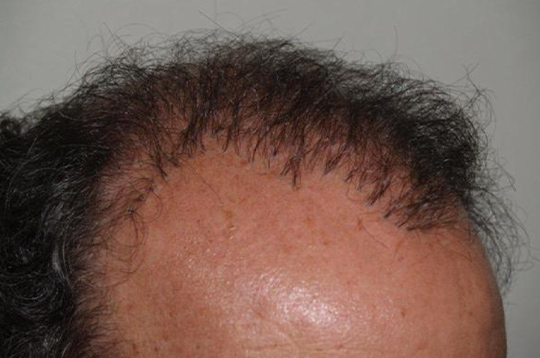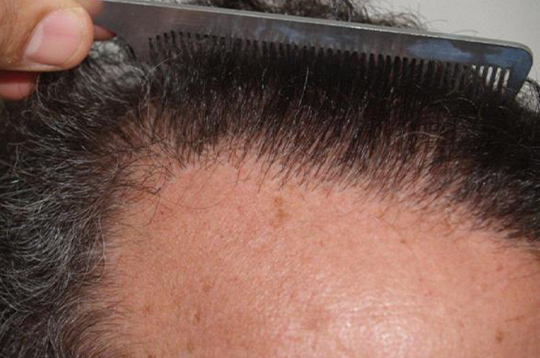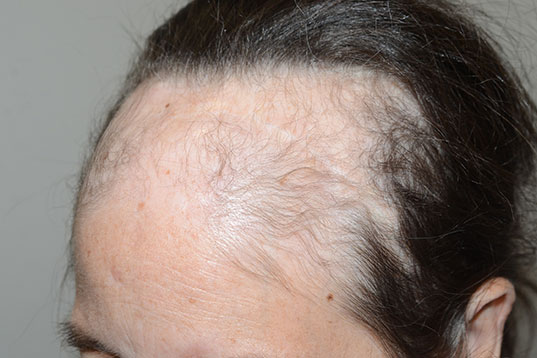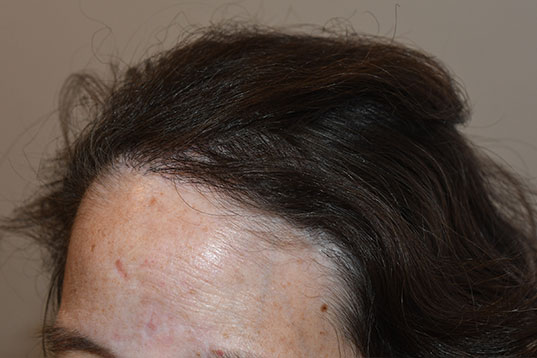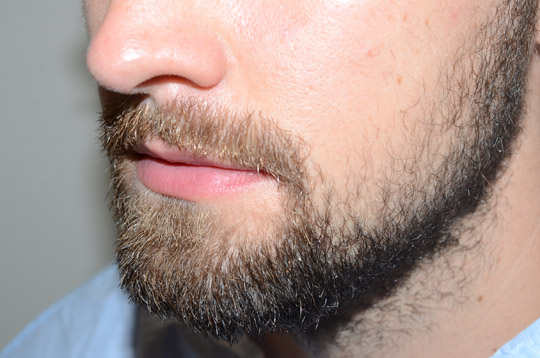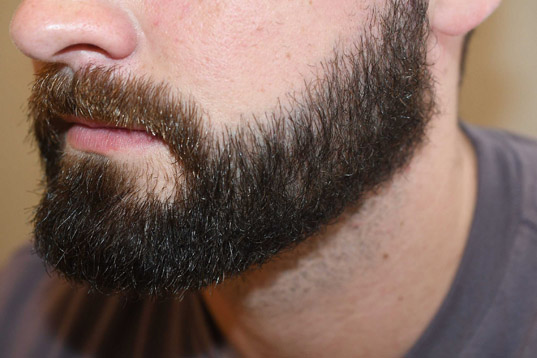During a hair transplant, the surgeon harvests hair follicles—most commonly from an area of the scalp or, in some cases, the body (particularly the beard)—and transplants them to an area suffering from hair loss. The results are permanent and help to restore patients’ confidence in their appearance. Learn more about your hair transplant options at Foundation Aesthetic Hair Restoration.
Hair Transplant
ACTUAL PATIENT
Causes of Hair Loss in
Men and Women
Although you might picture a balding man when you think of hair loss, the truth is that both men and women can and do lose their hair. The reasons for hair loss can differ from person to person. In many cases, hair loss is genetic. Both men and women can experience hereditary hair loss, which is known as androgenic alopecia. When it occurs in men, androgenic alopecia is called male pattern baldness. In women, it’s called female pattern baldness. When someone has androgenic alopecia, the hair follicles in certain areas of their scalp start to shrink. The follicles eventually get so small that they can’t produce hair.
In men, hair loss most often occurs on the top of the head or with a receding hairline. In women, androgenic alopecia typically, but not always, presents as more diffuse hair loss. Often, the first signs of female pattern baldness are a wider part or noticeable thinning of the hair. While pattern baldness is the most common type of hair loss, there are many other potential causes, particularly in women, where medical issues can be contributing factors.
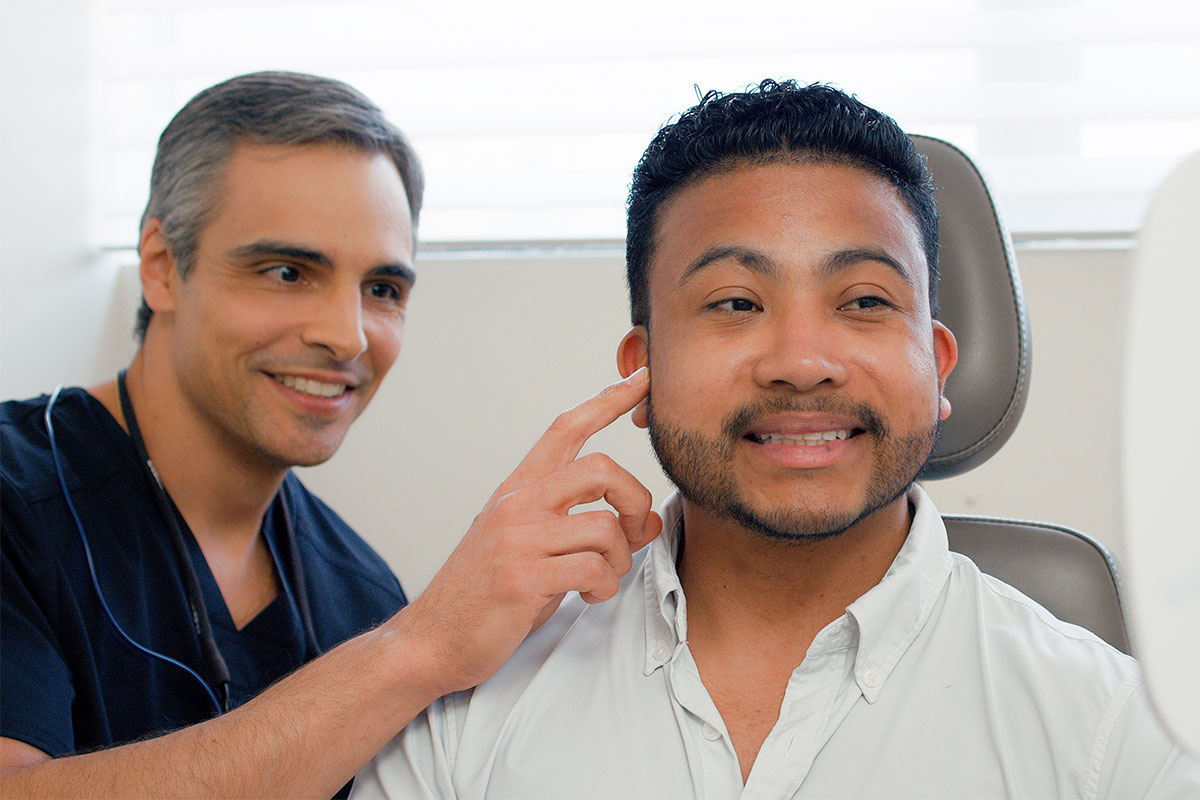
ACTUAL PATIENT
Stress-Induced Hair Loss
One relevant cause of thinning hair in men and women is stress. Hair loss due to stress is called telogen effluvium. Unlike androgenic alopecia, it’s usually not permanent, but it can accelerate pattern hair loss, which will not regrow. When someone experiences telogen effluvium, more hair than usual moves into a resting phase, then sheds. The hair usually grows back once the stress causing it has diminished.
Hair loss can also be caused by various factors, including certain medications, anemia, tight hairstyles (traction alopecia), scalp conditions, hormone imbalances, and other conditions, including alopecia areata an autoimmune disorder. Before you schedule a hair transplant, it’s important to work with a doctor to diagnose the root cause of your hair loss. Knowing what’s contributing to your hair loss will help you determine the best way to treat it.
How a Hair Transplant Works
The best way to understand how a hair transplant works is to think of it as a surgery that moves hair from one area of the scalp or body where the hairs are genetically programmed to be permanent, to another. The surgery is also sometimes called hair restoration or hair grafting.
When a man experiencing male pattern baldness wants a hair transplant, the surgeon will usually choose hair from the sides or back of the scalp to act as the donor hair follicles. Men with male pattern baldness usually don’t ever lose the hair on the sides or back of the head.
If a woman wants a hair transplant, the location of the donor follicles will depend on the type of hair loss she is experiencing. However, as with most cases, they are most commonly taken from the back of the head.
It’s also possible to transplant body hair to the scalp or to move hair from the scalp to another area, such as the eyebrows, chest, or beard.
During the first part of the hair restoration surgery, the surgeon will extract the hair follicles from the donor site. How they will remove the follicles depends on the hair transplant method they’re using.
In nearly all cases, the preferred method is to harvest the the follicle groups one by one in the technique of follicular unit extraction (FUE). In the occasional case, the surgeon will cut away a strip of skin containing many follicle groups (FUT or strip surgery) and have the follicles dissected out from the strip.
After harvesting, the follicles are prepared, then transplanted one at a time into carefully made recipient sites in the area to be filled in. How long this process takes depends on the number of follicles being transplanted and area(s) being worked on, as well as the method of how the FUE is performed.
The procedure is typically completely painless, and recovery after takes only a few days. The transplanted hair will typically fall out within a week or two. It will start to regrow after several months and any new growth will be permanent.
Anesthesia During a Hair Transplant
Surgeons typically do not use general anesthesia during hair restoration procedures, as it is unnecessary. Instead, patients will be given a local anesthetic, similar to what you might receive before a dental treatment (but often much more comfortable), along with oral sedation and, if desired, nitrous oxide (laughing gas). At Foundation Aesthetic Hair Restoration, we also offer twilight (IV) sedation, which allows the patient to essentially sleep through most, if not all, of the surgery.
With local anesthetic, patients feel nothing on the scalp while the grafts are harvested then transplanted. If you choose to receive twilight sedation, you’ll be asked not to eat or drink anything for 8 hours before your hair transplant.
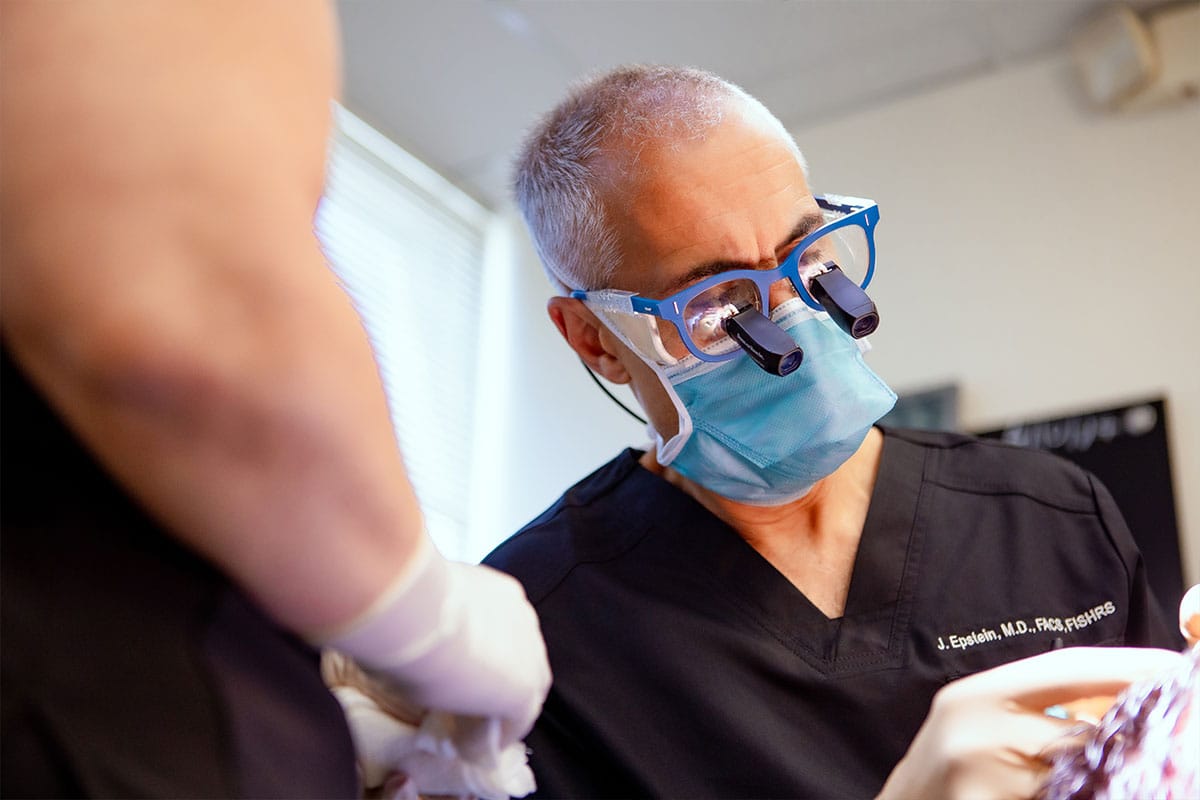
Hair Restoration Candidates
The type and extent of your hair loss will determine whether you’re a good candidate for a hair transplant. Often, candidates have already lost a significant amount of hair, but others may have only mild recession or thinning.
While it can be tempting to address hair loss as soon as it becomes noticeable, many surgeons recommend waiting and starting with medical therapy. This approach may help stop or slow the progression of hair loss, thicken existing hairs, and possibly reduce the need for surgery.
Since hair can regrow after certain types of hair loss, waiting gives your body a chance to recover naturally. Strengthening thinning hairs before surgery also lowers the risk of shock loss—a temporary shedding of existing hairs—by making them more resilient during the transplant process.
Different Types of Hair Transplants
FUE Hair Transplant
Follicular unit extraction (FUE) is a more refined delicate procedure, as each follicular group is harvested individually. FUE offers several benefits over FUT. First, removing the follicles one at a time eliminates the linear scar that FUT produces. FUE creates tiny dot-like scars on the scalp, which are typically minimally visible—or not visible at all—once healed, even under short hair. Healing is typically painless and also faster after FUE. FUE also allows for the harvesting of hairs from various areas of the scalp. Ultra-fine hairs along the nape of the neck can be selected for transplantation along the hairline, while higher-quality grafts can be harvested from the upper sides of the head.
Additionally, removing follicles one by one enables the surgeon to select only the best grafts—those containing the most ideal hairs—for more refined and natural-looking results. Each graft typically contains 1 to 3 hairs, and occasionally up to 4. The surgeon transplants these grafts individually, placing them in a natural pattern throughout the scalp.
Megasession Hair Restoration
If you have a significant amount of hair loss, the megasession hair transplant procedure offers a modern and advanced way to restore a full head of hair in the shortest amount of time. A megasession hair transplant takes one full day, and sometimes the patient returns the next day for several more hours of work to obtain the maximum number of grafts—ranging from 3,000 to as many as 4,500 or more.
These large hair restoration procedures provide extensive coverage and significant density. While many patients are satisfied with their results after the first megasession hair transplant, some undergo a second procedure—typically 10 or more months later—to further improve density and/or coverage.
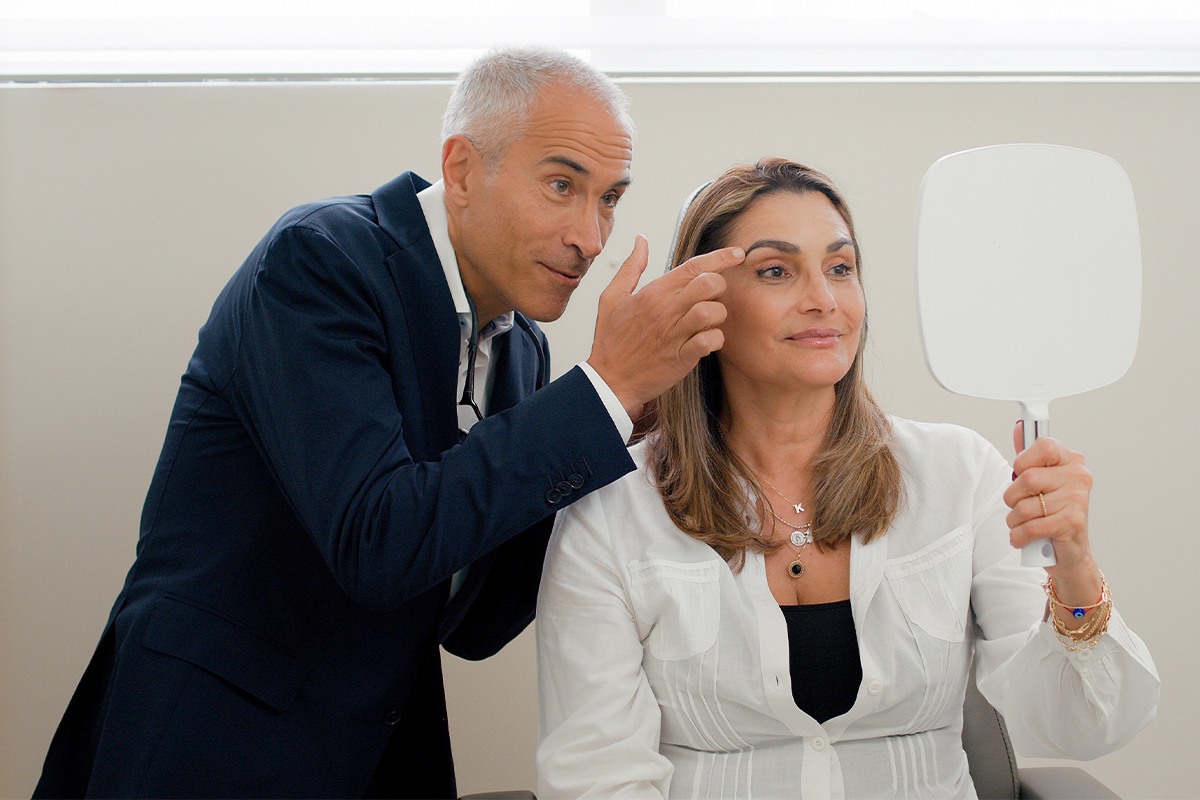
ACTUAL PATIENT
Hair Transplants for Women
Hair loss is almost as common in women as it is in men. Yet, many surgeons don’t recommend or perform hair transplants for women. Dr. J. Epstein and the hair restoration specialists at Foundation Aesthetic Hair Restoration in Miami understand that women can benefit from hair transplants as much as men.
The first thing to do when deciding if a hair transplant is the right option for a woman is to determine the cause of her hair loss. Some types of hair loss respond to the hair restoration procedure better than others. In some cases, if the hair loss is temporary, taking a wait-and-see approach might be best.
Women often also benefit from a combined approach to hair loss treatment. In addition to hair restoration surgery, a woman might use a topical hair loss medication, take vitamin supplements, change her hairstyle, undergo scalp micropigmentation (SMP), or monitor her hormone levels.
FUT Hair Transplant
Follicular unit transplantation, or FUT, is also called the strip method. During the harvesting phase of the procedure, the surgeon will cut out a strip of skin from the scalp, containing the hair follicles that will get transplanted to the recipient area.
Once the strip is harvested, the surgeon will close the area with sutures. As the donor site heals, a small, linear scar will develop. Most people can cover the scar with their remaining hair, and the incision is designed to allow hair to grow through it, so it’s not visible. Since the surgeon harvests all the donor hair at once, FUT hair transplants usually take less time than FUE hair transplants. This is not usually the preferred procedure, but it is occasionally performed by our surgeons—most commonly on patients who have previously undergone an FUT procedure and wish to have it repeated instead of opting for FUE.
Forehead Reduction
As an alternative or in addition to hair transplantation, some women choose forehead reduction surgery. Also known as hairline lowering surgery, a forehead reduction procedure brings the hairline forward. The surgery makes the forehead look smaller and the hairline more advanced.
It can help to reverse the appearance of a receding hairline or correct a naturally high forehead. If the hair in the area is thin, it’s possible for patients to combine a forehead reduction surgery with a transplant to create a fuller head of hair. The main advantages of hairline lowering surgery are the virtually instantaneous results, and the density equivalent to the transplanting of 5,000 to 6,000 grafts.
African American Hair Transplants
Some types of hairstyles are more damaging to the hair and follicles than others. Tight ponytails and braids contribute to traction alopecia. The use of heat or harsh hair treatments can also affect hair growth.
In the Black community, harsh hair treatments frequently lead to hair loss. Black men and women are also just as likely as people of other ethnicities to experience male or female pattern baldness. Also certain medical conditions such as scarring alopecia can occur more commonly in the Black patient.
Black hair has unique features and tends to be curly, which can make it more challenging to harvest and transplant during hair restoration. It’s important to find a hair transplant surgeon who has experience working with textured hair for the best results.

Body Hair Transplants
While the hair on the scalp tends to get a lot of attention, it’s not the only type of hair that can be restored. Dr. J. Epstein also offers body hair transplants to patients. Often, the goal of a body hair transplant isn’t to restore hair but to allow hair to grow in areas where it did not previously. For example, some people decide to transplant hair to their chests to create a fuller look.
Some people also want to transplant hair to the beard or mustache area. That can be particularly true for people who want facial hair but who find that it naturally grows in patchy or uneven patterns. The eyebrows are another popular location for a body hair transplant. Many people overplucked their brows or waxed too much when thin brows were trendy. They now find that the plucked or waxed brow hair isn’t growing back adequately.
Body hair restoration can use the hair from the scalp or from another area of the body. Once it’s transplanted to the new area, such as the beard or brows, it will start to grow like the other hair in that area.
Another form of body hair transplantation (BHT) involves transplanting beard hairs—typically chosen for their reliable regrowth—to the scalp. The ability to harvest hair from the beard can significantly expand the total donor supply, adding between 700 and 7,000 grafts. This can be especially beneficial for men who have undergone multiple prior transplants resulting in a depleted scalp donor supply, as well as those with advanced hair loss who are seeking maximum coverage beyond what scalp donor hairs alone can provide.
Choosing a Hair Transplant Surgeon in Miami
When choosing a hair transplant surgeon, it’s critical to work with someone who has extensive experience with hair restoration, your hair type, and the type of surgery you want.
The surgeons at the Foundation Aesthetic Hair Restoration, Dr. J. Epstein and Dr. Anthony Bared, have decades of experience with hair restoration and have performed thousands of Miami hair transplant procedures.
These surgeons have performed scalp, eyebrow, and beard transplants, as well as hairline lowering surgeries.
A consultation with a Miami hair transplant surgeon before your procedure allows you to get to know your surgeon and to learn more about what to expect from the surgery.
Hair Transplant Recovery
Initial recovery is usually pretty quick after a hair transplant. The surgery typically causes little to no discomfort and many patients feel ready to return to work or other activities after just a few days. Full exercise can be resumed on the sixth day. Usually, the transplanted hair falls out after two to three weeks, then you’ll start to see new growth after several months, but until then, you can expect to look as you did before your hair restoration surgery.

Hair Transplant Post-Op instructions
After your hair transplant, your surgeon will provide you with a detailed list of instructions. It’s important to follow these instructions closely, as doing so will help improve your results and speed up hair regrowth.
The instructions will let you know when you can wash your hair again and when it’s safe to color or use hair styling tools. Your surgeon will also let you know what you need to avoid during the recovery.
How Much Do Hair Transplants Cost?
The cost of a hair transplant can vary widely. Several factors influence the price of the surgery. The number of hairs you want to transplant affects the cost, as does the extraction method the surgeon uses.
The surgeon’s skill and reputation can also affect the price of a hair transplant. Less experienced surgeons might charge less than one with years of experience and thousands of surgeries under their belt. In most cases, however, you get what you pay for—experienced surgeons charge what their skills are worth.
Location is another factor that influences surgical costs. Some areas of the country have higher prices for hair restoration than others. While there is a fair amount of variation when it comes to the surgical cost, the average price of a hair transplant is around $12,000 but can go as high as $30,000 or more.
During your consultation, once the appropriate procedure has been determined, you will be provided with information on fees as well as available financing options.
FAQs
Is a hair transplant right for me?
Whether or not a hair transplant is right for you depends on the type of hair loss you have and how severe the loss is. If you’re concerned about your hair, your best bet is to talk to a hair restoration surgeon about your options.
Do I have to use my own hair?
Yes, hair transplant patients need to use donor hair from their own bodies. If hair from another source is used, the body will reject it.
What type of anesthesia is used during a hair transplant?
The surgeons at Foundation Aesthetic Hair Restoration use a local anesthetic and oral sedation, along with ProNox® nitrous oxide if desired. Twilight (IV) sedation is also available for patients who prefer a deeper level of relaxation.
Will I continue to lose hair after a hair transplant?
Hair restoration corrects existing hair loss but does not prevent future hair loss from occurring. Depending on how your hair loss progresses—or when you choose to have your first hair transplant—you may decide to undergo another procedure in the future. Preventative therapy can also help slow or prevent the progression of hair loss.
What other hair loss treatments are available?
Non-surgical hair loss treatments, such as topical compounded and oral medications, might help slow down or reverse hair loss in some patients. The treatments aren’t permanent, however, and need to be used consistently for the results to continue.
When can I style my hair again after a hair transplant?
Your surgeon will let you know when it’s safe to begin styling your hair again. Usually, you can resume regular washing within a week, though you’ll need to wait a few weeks before dyeing your hair or using styling products.
Schedule a Hair Transplant Consultation in Miami Today
If a hair transplant sounds like the solution to your hair loss frustrations, contact the Foundation Aesthetic Hair Restoration in Miami, Florida, today. Our team of board-certified, experienced hair restoration surgeons can talk to you about your hair loss and recommend the course of treatment that’s best for you. Call 305-680-5918 to book a consultation for a hair transplant today.
ACTUAL PATIENT
Contact Us Today
Start Your
Journey
Have questions? Reach out today
for answers and more information.

